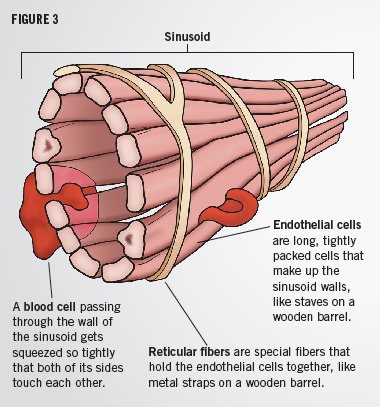The Mysterious Spleen
While most people have heard of “a ruptured spleen,” few can tell you anything about it. Why is the spleen even in our bodies? This amazing organ quietly serves several invaluable roles in our blood system, keeping our bodies healthy.
The spleen! . . . What’s the spleen?
That might be how most people respond to any mention of this organ in our body. While most people have heard of the spleen, few could tell you what it does or even where it’s located.
That’s a pity since the spleen is an amazing organ that clearly shows the wisdom and handiwork of our Creator. (Although the spleen serves some very important functions, when necessary we can live without it—thanks to our accommodating liver.)
Many of the organs in our body come in pairs, such as the kidneys and lungs, but the spleen is one of the unpaired organs in the body. Usually the unpaired organs, such as the heart, are located along the midline of the body, but the spleen is located on the left side of the body just under the rib cage and to the left of the stomach and pancreas (Figure 1). This is a well-protected location, but a hard blow to the left side can break ribs which could rupture the spleen and cause massive internal bleeding.

© 2011 Nucleus Medical Media, All rights reserved. www. nucleusinc.com
A BLOOD CELL STOREHOUSE Tucked behind our stomach is the spleen, a small organ about the size of our fist. Inside is a dense concentration of red blood cells called the red pulp. The spleen stores red blood cells and platelets, but it serves many other important functions.
Functions of the Spleen
This blood-filled organ serves several important functions.
Storage of Blood and Platelets. Although the spleen is only about the size of our fist, at any given moment about 4% of all the blood in our body is passing through the spleen.
In some carnivorous animals, the spleen stores red blood cells packed together like “paste” that can provide a “blood transfusion” in the event of a serious wound. But the human spleen primarily stores blood platelets (about one third of the body’s platelets). Blood platelets are special cell fragments circulating in the blood. They prevent excessive internal or external bleeding by forming clots that plug damaged blood vessels like a self-sealing tire.
But the spleen’s most important functions are not simply storage of blood cells and platelets.
A Blood Filter. One of the spleen’s most important functions is to filter out microorganisms and foreign particles that have entered our bloodstream. For instance, in experiments, scientists have observed that foreign dye particles discoloring the blood can be entirely removed in one pass through the spleen.
Not only does the spleen remove foreign particles and microorganisms, it also removes worn-out and defective red blood cells. Because of this, the spleen may have to be removed from patients with sickle cell anemia lest the spleen destroy all of the patient’s defective sickle-shaped red blood cells. After all, even bad blood is better than no blood. Thanks be to God that, when the spleen is removed, the liver can take over some of the spleen’s functions.

© 2011 Nucleus Medical Media, All rights reserved. www.nucleusinc.com
The removal of defective or worn-out blood cells occurs in certain areas of the spleen called the red pulp (Figure 2), named for the high concentration of red blood cells. Red blood cells normally circulate in our blood vessels for about 120 days before they wear out. During its life span each red blood cell makes many trips through the spleen, where it is subjected to a grueling gauntlet that tests cell function and flexibility. Those blood cells failing to pass the tests are removed from circulation.
Blood passing through the spleen may take either a direct closed route through its blood vessels or an indirect open route where the blood temporarily leaves the blood vessels. (If blood leaves the blood vessels almost anywhere else in our body, it results in massive blood clotting or internal bleeding.) Those blood cells that leave the blood vessels in the spleen’s red pulp must essentially find their own way back into circulation by squeezing through the walls of special blood vessels called sinusoids. This strange arrangement actually tests the flexibility of the red blood cells.


Photos courtesy Dr. David Menton
BLOOD FILTERS (SINUSOIDS) One of the spleen’s functions is to test and remove worn-out and defective red blood cells. Each red blood cell must endure grueling tests, including something like a clothes ringer. To pass the test, the cell must squeeze through the walls of special blood vessels called sinusoids. Any cell failing to pass the test is removed from circulation.
The walls of the spleen’s sinusoids are made up of elongated cells that look like the wood staves forming the wall of a wooden barrel. Special reticular fibers hold the stave-like cells together, much like the metal strapping around the wooden barrel. Blood cells get back into circulation by squeezing between the stave-like cells of the sinusoid (Figure 3).
These closely packed cells act like a clothes wringer. When a blood cell passes through the wall of the sinusoid, it gets squeezed so tightly that both sides of its cell membranes touch each other (Figure 3). If the red blood cell has any inflexibility or any abnormal granules, it is removed from circulation and devoured by nearby cells called macrophages (which means “big eaters”). The iron in the hemoglobin of these cells is then recycled to make new red blood cells.
Lymphoid function of the spleen. When a fresh spleen is sliced open, it has an overall red appearance due to its dense content of red blood cells. But scattered throughout this red pulp are white patches called white pulp that contain mostly the colorless cells of our lymphoid system (Figure 2).
The cells of the lymphoid system consist largely of lymphocytes and plasma cells, which protect our body from infections by microorganisms, foreign cells, and antigens (foreign proteins). These cells are produced in our primary lymphoid organs—the bone marrow and thymus gland—and find their way into our secondary lymphoid organs—lymph nodes, tonsils, and spleen—where they serve their protective function as part of our immune system.
The white pulp of the spleen is rich in B lymphocytes from the bone marrow and T lymphocytes from the thymus. Whenever antigens are discovered in the blood, B lymphocytes turn into plasma cells that make and release antibodies into the blood to destroy the antigens.
Early in our development in the womb, T cells learn to recognize the proteins of our own body and to distinguish them from foreign proteins. Throughout life, our T cells constantly scan the surface of cells in our body, looking for evidence of foreign proteins or protein fragments called peptides that indicate a cell is infected with bacteria or has become cancerous. When a foreign protein is detected, the cell containing the protein is destroyed by the T cell in a process called cell-mediated immunity.
This function of T cells explains graft rejections by people who have had tissue or organ transplants. T cells may be adversely affected in diseases that harm the immune system, such as AIDS and certain cancers like lymphoma.
The Blood Is the Life and the Spleen Is Its Lifeguard
One popular Christian painting shows an angel watching over two young children crossing a dangerous stream on a rickety bridge. The spleen is something like that—standing watch over our bloodstream.
Some of the spleen’s functions may not have been necessary before the Fall, but in our fallen world this organ watches for cancer cells, harmful bacteria, and other foreign substances in our blood. Let us thank our Creator, the Lord and Savior Jesus Christ, for the “watchful eye” of this marvelous organ that helps preserve us until He raises our glorified body to dwell with Him for eternity.
Answers Magazine
October – December 2011
Answers magazine has decided to do some myth-busting. This issue will examine some of the most popular myths about the dinosaurs and how they died. Along the way, you’ll learn some other cool facts about these amazing creatures—quick, can you name the smallest kind of dinosaur? We will also examine some serious contemporary issues, such as the increase of biblical compromise in homeschool materials and the dangers of the new leader in “theistic evolution,” known as the BioLogos Foundation.
Browse IssueRecommended Resources

Answers in Genesis is an apologetics ministry, dedicated to helping Christians defend their faith and proclaim the good news of Jesus Christ.
- Customer Service 800.778.3390
- Available Monday–Friday | 9 AM–5 PM ET
- © 2026 Answers in Genesis




